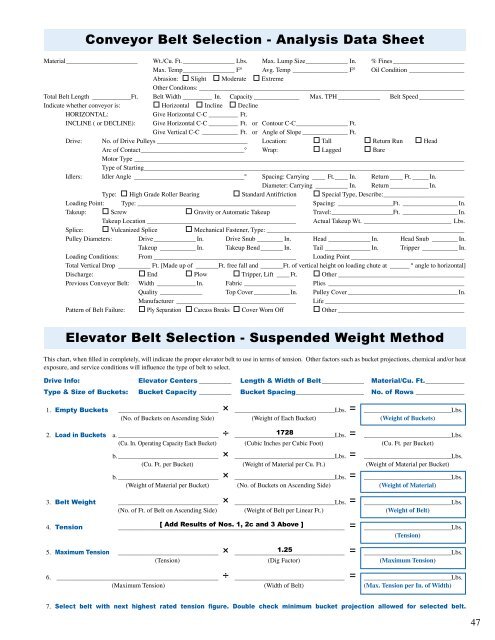Beltservice Corporation
You also want an ePaper? Increase the reach of your titles
YUMPU automatically turns print PDFs into web optimized ePapers that Google loves.
Conveyor Belt Selection - Analysis Data Sheet<br />
Material______________________ Wt./Cu. Ft.________________ Lbs. Max. Lump Size_____________ In. % Fines______________________<br />
Max. Temp________________ F° Avg. Temp _________________ F° Oil Condition _________________<br />
Abrasion: Slight Moderate Extreme<br />
Other Conditons: __________________________________________________________________________________<br />
Total Belt Length ____________Ft. Belt Width _________ In. Capacity ______________ Max. TPH _____________ Belt Speed ______________<br />
Indicate whether conveyor is: Horizontal Incline Decline<br />
HORIZONTAL:<br />
Give Horizontal C-C _________ Ft.<br />
INCLINE ( or DECLINE): Give Horizontal C-C _________ Ft. or Contour C-C________________ Ft.<br />
Give Vertical C-C ___________ Ft. or Angle of Slope ______________ Ft.<br />
Drive: No. of Drive Pulleys ____________________________ Location: Tall Return Run Head<br />
Arc of Contact________________________________° Wrap: Lagged Bare<br />
Motor Type ______________________________________________________________________________________________________<br />
Type of Starting___________________________________________________________________________________________________<br />
Idlers: Idler Angle __________________________________° Spacing: Carrying ____ Ft.____ In. Return ____ Ft. _____In.<br />
Diameter: Carrying __________ In. Return ____________In.<br />
Type: High Grade Roller Bearing Standard Antifriction Special Type, Describe:_________________________<br />
Loading Point: Type: _________________________________________________ Spacing: _________________Ft. _________________In.<br />
Takeup: Screw Gravity or Automatic Takeup Travel:___________________Ft. _________________In.<br />
Takeup Location ______________________________________________ Actual Takeup Wt. ___________________________ Lbs.<br />
Splice: Vulcanized Splice Mechanical Fastener, Type: _____________________________________________________________<br />
Pulley Diameters: Drive_____________ In. Drive Snub ________ In. Head _____________ In. Head Snub ________ In.<br />
Takeup ___________ In. Takeup Bend_______ In. Tail ______________ In. Tripper ___________ In.<br />
Loading Conditions: From ____________________________________________ Loading Point ___________________________________<br />
Total Vertical Drop __________ Ft. [Made up of _______Ft. free fall and _______Ft. of vertical height on loading chute at ______ ° angle to horizontal]<br />
Discharge: End Plow Tripper, Lift ____Ft. Other _______________________________________<br />
Previous Conveyor Belt: Width ____________In. Fabric ________________ Plies __________________________________________<br />
Quality _____________ Top Cover ___________In. Pulley Cover__________________________________In.<br />
Manufacturer _____________________________________ Life ___________________________________________<br />
Pattern of Belt Failure: Ply Separation Carcass Breaks Cover Worn Off Other _______________________________________<br />
Elevator Belt Selection - Suspended Weight Method<br />
This chart, when filled in completely, will indicate the proper elevator belt to use in terms of tension. Other factors such as bucket projections, chemical and/or heat<br />
exposure, and service conditions will influence the type of belt to select.<br />
Drive Info: Elevator Centers __________ Length & Width of Belt _____________ Material/Cu. Ft. ____________<br />
Type & Size of Buckets: Bucket Capacity __________ Bucket Spacing _____________________ No. of Rows _______________<br />
1. Empty Buckets a. _______________________________ × _______________________________Lbs. = ___________________________Lbs.<br />
(No. of Buckets on Ascending Side) (Weight of Each Bucket) (Weight of Buckets)<br />
2. Load in Buckets a. _______________________________ ÷ _______________________________Lbs. = ___________________________Lbs.<br />
(Cu. In. Operating Capacity Each Bucket) (Cubic Inches per Cubic Foot) (Cu. Ft. per Bucket)<br />
b._______________________________ × _______________________________Lbs. = ___________________________Lbs.<br />
(Cu. Ft. per Bucket) (Weight of Material per Cu. Ft.) (Weight of Material per Bucket)<br />
× _______________________________Lbs. = ___________________________Lbs.<br />
b._______________________________<br />
(Weight of Material per Bucket) (No. of Buckets on Ascending Side) (Weight of Material)<br />
3. Belt Weight a. _______________________________ × _______________________________Lbs. = ___________________________Lbs.<br />
(No. of Ft. of Belt on Ascending Side) (Weight of Belt per Linear Ft.) (Weight of Belt)<br />
4. Tension a. ______________________________________________________________________<br />
[ Add Results of Nos. 1, 2c and 3 Above ]<br />
= ___________________________Lbs.<br />
(Tension)<br />
5. Maximum Tension a. _______________________________ × __________________________________ = ___________________________Lbs.<br />
(Tension) (Dig Factor) (Maximum Tension)<br />
6. __________________________________________________ ÷ __________________________________ = ___________________________Lbs.<br />
(Maximum Tension) (Width of Belt) (Max. Tension per In. of Width)<br />
1728<br />
1.25<br />
7. Select belt with next highest rated tension figure. Double check minimum bucket projection allowed for selected belt.<br />
47

















